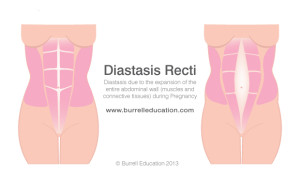If you are pregnant, or have recently had a baby, you may have heard of Diastasis Recti. I have written about this before, but since it is the #1 topic that people ask me about, and something that I have dealt with myself postpartum, I feel it’s important enough to write about again!
So what is it? Diastasis Recti is a condition in which the ligament tissue between your rectus abdominal muscles (6 pack muscles) is weakened causing them to separate resulting in core instability and weakness. Read on for the Who, What, Where, When, Why & How of Diastasis Recti.

Who gets Diastasis Recti?
Diastasis recti can happen to anyone, including men and babies! Although it is seen in other populations, it is often found in pregnant or postpartum women, and is most common in those with multiple births or many pregnancies. Surprisingly it is not related to Body Mass Index (BMI), weight gain, baby’s weight or abdominal circumference (Source).
What is Diastasis Recti?
Diastasis Recti abdominis is an “impairment characterized by a midline separation of the rectus abdominis muscles along the linea alba” (Source). Diastasis recti looks like a ridge that runs down the middle of the abdominals from the bottom of the breastbone to the bellybutton (source). It increases with abdominal strain, such as sitting up from a lying position or lifting a heavy load. Sometimes Diastasis Recti is not visible, and is difficult to diagnose based on appearance. I noticed this myself since after pregnancy my stomach appeared ‘normal’ but upon testing I realized I still had a 3 or 4-finger width separation at 4 weeks postpartum.
Diastasis Recti can be present for years after childbirth and can be responsible for the ‘mommy pooch’ or bulging appearance even long after having the baby.
You can test for Diastasis Recti by lying flat on your back, and placing your fingers along your midline about an inch or two above your bellybutton. As you lift your head off the ground into a crunch position feel with your fingers the margins of your abdominal muscles. If there is an area along the center that feels ‘weak’ or ‘hollow’ it is possible that you have a diastasis. You want to feel for two things, how wide is the space between your abdominals and how deep your fingers sink into your abdominal cavity. No, this doesn’t mean your abdominals are completely torn apart and you need surgery, it simply means that the connective tissue holding them together is weak, and rehabilitation is recommended in order to gain back your core strength and reconnect your core muscles.
Where can I get help?
I always recommend that women seek the help of a physical therapist who specializes in women’s health. People who have a diastasis often have other underlying issues such as a weak pelvic floor or low back pain that can be resolved with specific exercises and techniques prescribed by a women’s health therapist.
If you have a mild diastasis and want to try some things at home please contact me to learn more about how I can help you develop a core strengthening program tailored to your specific needs.
When can I start healing my Diastasis Recti?
Now! The first thing you can do is modify the way you do your everyday activities. By making small changes you can already begin to heal your core!
- Getting out of bed
- Roll on your side before getting out of bed. Let your legs hang off the edge and use your arms to raise your body to a sitting position. This will really help unload the strain from your abdominal muscles.
- Lifting heavy objects
- Before lifting anything heavy off the ground be sure to start in a squat position. Brace your core by ‘sucking in’ and pulling your bellybutton to your spine. This will give you the feeling of a flat stomach and this tension will help protect your weak abdominals.
- Lifting overhead
- Avoid lifting heavy objects overhead when possible. When necessary be sure to use the same core tightening technique described above.
- Avoid abdominal exercises
- Of course we all want to get a flat stomach after having a baby but by engaging in activities such as crunches, planks, V sits, leg bicycles, abdominal twists and yoga poses such as boat pose, before your diastasis is healed you are putting yourself at risk of making it worse! Some women have told me that they notice their stomach is bulging out more instead of getting flatter after exercise. This is a sure sign that you may be making your diastasis worse!
Why should I care?
Diastasis recti can remain present for months (or years!) after childbirth. A diastasis wider than 2 finger widths has the potential to cause long-term problems related to poor core strength such as low back pain, umbilical hernia, and pelvic floor dysfunction. By taking the time to rehabilitate your core now you are setting yourself up for success in the future.
How can I do abdominal exercises to heal my Diastasis Recti?
There are a few key exercises that should be done in order to heal your diastasis. First and foremost your must be able to connect your breath to your core muscles. Start with focusing on your breathing and try using forced exhalation to activate your core muscles during exercise. If you are familiar with Pilates, every movement starts with a breath out. This breathing technique helps activate your core muscles and turn on your Transverse Abdominis, which is the muscle you want to work in order to reconnect your abs!
Please note…. these exercises build on one another, therefore if you are having difficulty stabilizing (e.g. your back lifts off the ground when moving your leg) then do not progress to the next exercise until your are strong enough to complete with proper form. It is not about quantity, but rather quality of the movement!
- Transverse Abdominis (TA) activation in lying: (this is your starting position for all the exercises) Lying flat on your back with your knees bent and your spine in a neutral position (e.g. not flat on the ground but not overarched) take a deep breath and on your breath out flatten your belly and feel like your are pulling your bellybutton to your spine. Hold here for 10 seconds and then repeat with another deep breath.
- Heel slides: In your starting position, activate your TA and slide your heel along the ground being aware not to lift your low back or hips off the ground. Repeat 3 sets of 15 reps
- Toe Touches: In your starting position, activate your TA and with your hips and knees at 90 degrees slowly lower one toe to touch the ground and alternate. Repeat 3 sets of 15 reps.
- Leg Lifts: In your starting position, activate your TA and with your legs straight slowly lower one leg to the ground (without letting it rest), alternate legs. Repeat 3 sets of 15 reps.
Please feel free to contact me or comment below with any questions! You can check out my previous blog posts related to Diastasis Recti by searching for them using the search bar below. I am currently taking continuing education courses to learn more on the subject so I hope to add more useful information to share with all of you soon!
In fitness & good health,
Natasha







I’m currently pregnant and can’t find any information on PREVENTING diastasis recti. Do you have any tips, suggestions or exercises?
Hey!
Honestly, I haven’t come across any research on ways to prevent DR. Unfortunately I think it’s just one of those things that happens to some people regardless. BUT…I would think that the tips I mentioned about not making it worse (such as avoiding ab exercises such as crunches and V sits, rolling on your side to get out of bed, etc) would help prevent it a little bit at least! I also am a huge believer in Kinesiotaping for DR, so that is definitely something to look into. There are some pictures on my instagram @fitmamasb that will give you an idea of what that looks like. Good luck with the rest of your pregnancy! 🙂